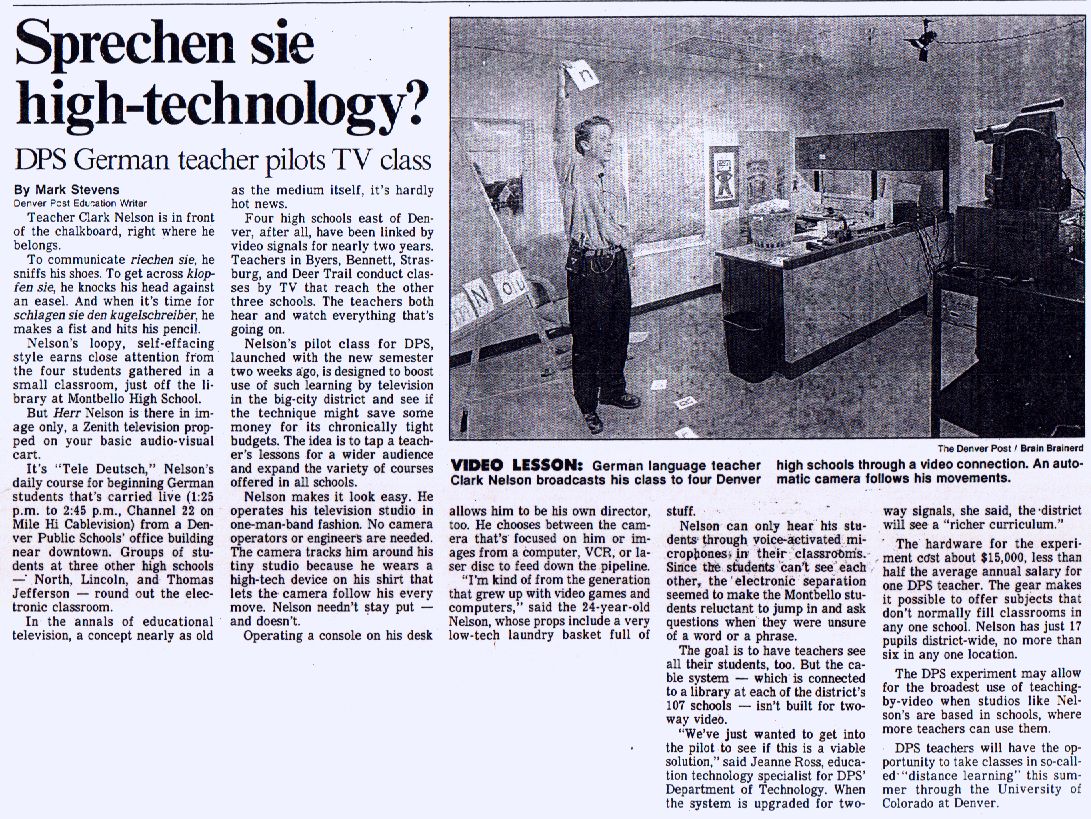Monday, 31 January 1994

The Denver Post
Monday, 31 January 1994

Teacher Clark Nelson is in front of the chalkboard, right where he belongs.To communicate riechen sie, he sniffs his shoes. To get across klopfen sie, he knocks his head against an easel. And when it's time for schlagen sie den kugelschreiber, he makes a fist and hits the pencil. Nelson's loopy, self-effacing style earns close attention from the four students gathered in a small classroom, just off the library at Montbello High School.
But Herr Nelson is there in image only, a Zenith television
propped on your basic audio-visual cart.
It's "Tele Deutsch," Nelson's daily course for beginning German
students that's carried live (1:24 p.m. to 2:45 p.m., Channel 22 on
Mile Hi Cablevision) from a Denver Public Schools' office building
near downtown. Groups of students at three other high schools --
North, Lincoln, and Thomas Jefferson -- round out the electronic
classroom. In the annals of educational television, a concept nearly
as old as the medium itself, it's hardly hot news. Four high schools
east of Denver, after all, have been linked by video signals for
nearly two years. Teachers in Byers, Bennett, Strasburg, and Deer
Trail conduct classes by TV that reach the other three schools. The
teachers both hear and watch everything that's going on.
Nelson's pilot class for DPS, launched with the new semester two weeks ago, is designed to boost use of such learning by television in the big-city district to see if the technique might save some money for its chronically tight budgets. The idea is to tap a teacher's lessons for a wider audience and expand the variety of courses offered in all schools.
Nelson makes it look easy. He operates his television studio in one-man-band fashion. No camera operators or engineers are needed. The camera tracks him around his tiny studio because he wears a high-tech device on his shirt that lets the camera follow his every move. Nelson needn't stay put -- and doesn't.
Operating a console on his desk allows him to be his own director, too. He chooses between the camera that's focused on him or images from a computer, VCR, or laser disc to feed down the pipeline.
"I'm kind of from the generation that grew up with video games and computers," said the 24-year-old Nelson, whose props include a very low-tech laundry basket full of stuff.
Nelson can only hear his students through voice-activated microphones in their classrooms. Since the students can't see each other, the electronic separation seemed to make the Montbello students reluctant to jump in and ask questions when they were unsure of a word or a phrase.
The goal is to have teachers see all their students, too. But the cable system -- which is connected to a livrary at each of the district's 107 schools -- isn't built for two-way video.
"We've just wanted to get into the pilot to see if this is a viable solution," said Jeanne Ross, education technology specialist for DPS' Department of Technology. When the system is upgraded for two-way signals, she said, the district will see a "richer curriculum."
The hardware for the experiment cost about $15,000, less than half the average annual salary for one DPS teacher. The gear makes it possible to offer subjects that don't normally fill classrooms in any one school. Nelson has just 17 pupils district-wide, no more than six in any one location.
The DPS experiment may allow for the broadest use of teaching-by-video when studios like Nelson's are based in schools, where more teachers can use them.
DPS teachers will have the opportunity to take classes in so-called "distance learning" this summer through the University of Colorado at Denver.